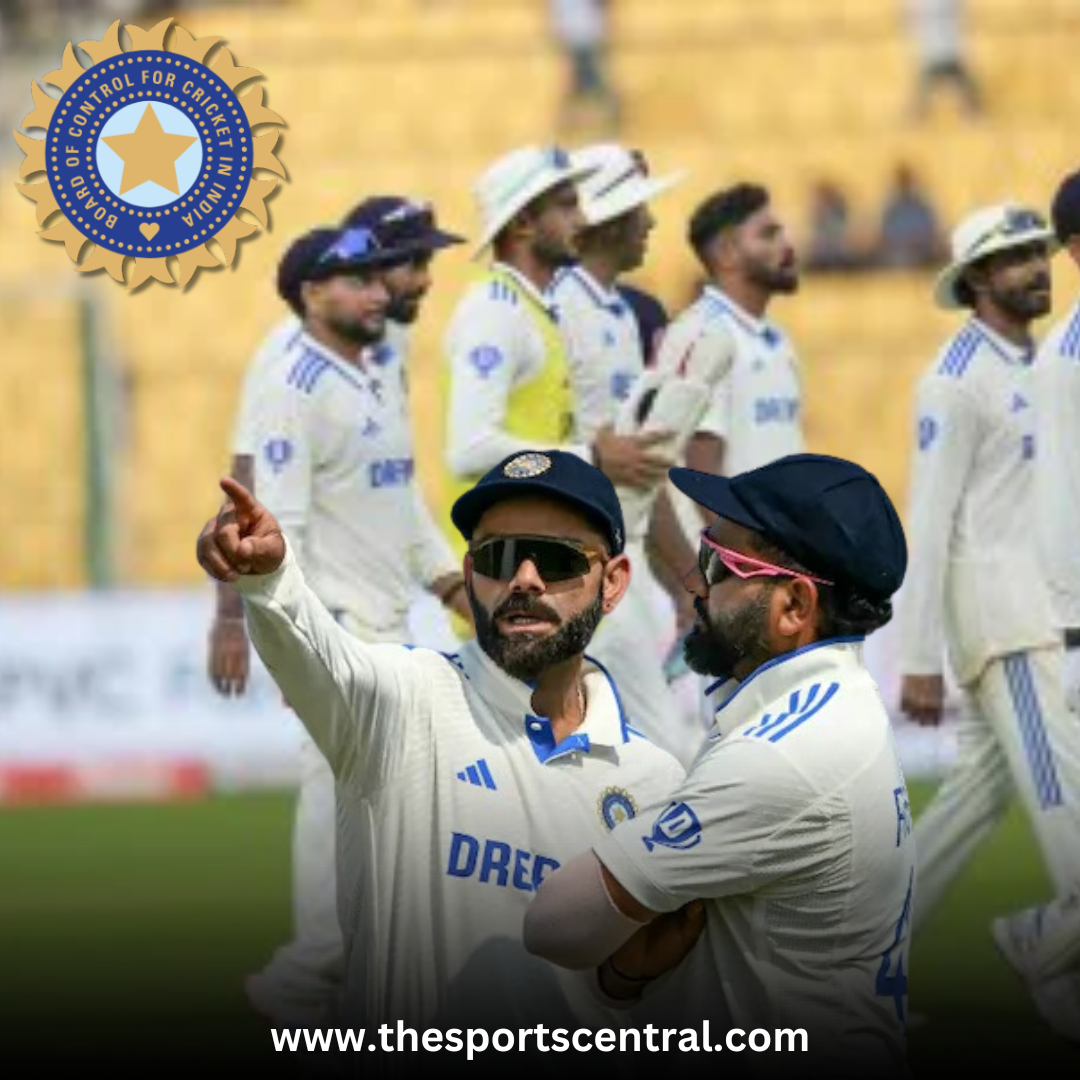India’s recent Test series losses have raised concerns among fans and experts alike. The Indian Test cricket team, which once stood as an invincible force, especially on home turf, has shown vulnerability. Losses to New Zealand in a historic series on home ground indicate a shift. Indian captain Rohit Sharma’s words after the series captured the pain of these losses, acknowledging the mistakes and missed opportunities. Could this be a signal that India’s golden era in Test cricket is fading?
Dominance in the Past Decade
For nearly a decade, India enjoyed dominance in Test cricket. Led by experienced captains and bolstered by a robust lineup, India consistently won series at home and abroad. Iconic players like Virat Kohli, Cheteshwar Pujara, and Ajinkya Rahane formed the backbone of the batting lineup, while bowlers like Ravichandran Ashwin, Ravindra Jadeja, and later Jasprit Bumrah tore through opposing teams.
India’s Test success was built on aggressive batting, skilled spin, and an impressive pace attack. The team didn’t just rely on home conditions; they managed to secure wins in challenging venues abroad. Victory in Australia and a closely contested series in England showcased India’s prowess. However, recent results suggest a decline.
Struggles in the ICC World Test Championship
The ICC World Test Championship standings reveal India’s recent struggles. Despite remaining a top contender, the Indian team faces fierce competition. In the current standings, India’s position isn’t as dominant as before:
| Team | Matches | Wins | Losses | Draws | Points | PCT |
|---|---|---|---|---|---|---|
| Australia | 12 | 8 | 3 | 1 | 90 | 62.50 |
| India | 14 | 8 | 5 | 1 | 98 | 58.33 |
| Sri Lanka | 9 | 5 | 4 | 0 | 60 | 55.56 |
| New Zealand | 11 | 6 | 5 | 0 | 72 | 54.55 |
| South Africa | 8 | 4 | 3 | 1 | 52 | 54.17 |
Australia currently leads with a PCT (points percentage) of 62.50, while India is at 58.33, trailing their usual dominant performance. The team’s recent losses to New Zealand have affected their standing, underscoring weaknesses that were previously overshadowed by victories.
New Zealand Series: A Wake-Up Call?
India’s recent Test series against New Zealand was historic but disappointing. New Zealand secured their first series win in India in over three decades, winning two out of three matches convincingly. In the first Test, India was bundled out for a mere 46 runs in the first innings, a stark contrast to their typical robust batting performances.
In the second Test, Mitchell Santner bowled brilliantly, securing match figures of 13 for 157. Santner’s performance was particularly remarkable, considering New Zealand spinners rarely dominate in Indian conditions. The third Test saw a similar story, with New Zealand’s Ajaz Patel taking 11 wickets. Patel’s exceptional bowling helped New Zealand complete a clean sweep, a feat no other visiting team had managed in India.
Key Issues in the Indian Team
1. Batting Vulnerabilities
India’s batting lineup, once known for resilience, has shown signs of fragility. In the first Test against New Zealand, India managed just 46 runs in the first innings, the lowest score in years. Even in subsequent matches, top-order collapses were common. Senior players, including Rohit Sharma and Virat Kohli, have struggled with consistency.
Rohit Sharma’s statement after the first Test loss reflected the team’s realization of their shortcomings. He noted that the Indian team didn’t play their best cricket and admitted the need for improvement. Consistency in batting remains a key concern, and as experienced players reach the twilight of their careers, a lack of emerging replacements has become evident.
2. Over-Reliance on Bowlers
India’s bowlers have long been the team’s saving grace. Jasprit Bumrah, Ravindra Jadeja, and R Ashwin have often turned games in India’s favor. However, the series against New Zealand highlighted an over-reliance on these key bowlers. Bumrah’s exceptional spell in the first Test nearly brought India back into the game, but with minimal support, the effort was insufficient.
Ravindra Jadeja and Ashwin, usually dominant in Indian conditions, were outperformed by Santner and Ajaz Patel. For the first time in years, Indian spinners were outbowled on home soil. While Washington Sundar showed promise, relying on young bowlers without sufficient support from senior players raises concerns about the team’s future.
3. Selection and Strategy
India’s selection choices and strategy have come under scrutiny. In the first Test, India opted for two spinners instead of a third seamer, despite conditions that favored seam bowling. The team’s inability to adapt to pitch conditions and select the right combination proved costly. Misreading pitches and sticking to outdated strategies hindered India’s ability to respond effectively to the opposition’s tactics.
The Impact of Departing Veterans
As experienced players age, India faces a pressing need for new talent. Virat Kohli, Cheteshwar Pujara, and Ajinkya Rahane have been pillars of India’s Test batting lineup. However, all three players are in their mid-thirties, with questions surrounding their longevity and form. Kohli’s recent form has been inconsistent, and Rahane has faced criticism for his lack of impactful performances.
Pujara, known for his patience and ability to anchor innings, hasn’t been as dependable in recent outings. India’s newer players, while talented, lack the experience and consistency needed to replace these veterans. The absence of strong middle-order players could be detrimental if the team doesn’t identify dependable replacements soon.
The Rise of Competition
India’s dominance in Test cricket is now challenged by rising teams like New Zealand and Australia. Australia has regained form, boasting a robust pace attack and a balanced batting lineup. New Zealand, often underestimated, has shown remarkable growth, especially with players like Devon Conway and Rachin Ravindra stepping up. England’s resurgence under new leadership also signals increased competition.
With every team aiming to win the ICC World Test Championship, the margin for error is small. India can no longer rely solely on home-ground advantage, as teams have adapted well to spin-friendly conditions in India. In recent years, India’s struggles in overseas matches and on challenging pitches have exposed gaps in the team’s skills.
Rebuilding and Adapting: A Need of the Hour
To return to dominance, India must adapt and rebuild strategically. Here are some key areas for focus:
1. Investing in Young Talent
India’s domestic circuit continues to produce talented players. Promising young players like Yashasvi Jaiswal and Washington Sundar have shown potential, but they need consistent opportunities and guidance from senior players. Selecting and nurturing young talent will be crucial in building a balanced team.
2. Strengthening the Bowling Department
India’s bowling lineup remains strong, but depth in both spin and pace is necessary. Relying on a few key players puts immense pressure on them. India should explore options for more balanced bowling combinations, especially with an eye on overseas conditions.
3. Refining Strategies and Game Plans
India’s strategy in the recent series against New Zealand revealed outdated approaches. Learning to adapt to conditions and selecting the right players for each situation is critical. India can look to other teams for strategies, such as rotating bowlers and using all-rounders effectively. This flexibility will allow the team to address its shortcomings dynamically.
4. Leadership and Mentorship
While Rohit Sharma’s captaincy has been effective, strong mentorship from retired players could benefit the younger team members. Players who have previously succeeded in challenging conditions can provide valuable insights and guidance. Mentorship programs can help bridge the experience gap left by departing veterans.
Is This Truly the End?
While India’s current form may suggest a decline, it’s too soon to declare the end of an era. Cricket’s cyclical nature means teams rise and fall over time. For India, this period could serve as a turning point, offering a chance to evaluate and address weaknesses. The road to reclaiming dominance may be challenging, but with the right adjustments, India can rebuild a team capable of long-term success.
The Way Forward
The path forward for India involves acknowledging the present challenges and making changes in preparation for the future. Focusing on youth, refining strategies, and encouraging adaptability will determine if India can maintain its position as a cricketing powerhouse. While the golden era may be experiencing turbulence, a return to form is not out of reach. The resilience of Indian cricket has been tested before, and with the right steps, India can look to future achievements with optimism.
In essence, India’s golden era in Test cricket may be at a crossroads. Whether it ends here or evolves into a new phase of success will depend on the team’s ability to adapt, innovate, and nurture new talent. The next few years will reveal if India can reclaim its dominant position or if they’ll need to redefine what success looks like in this new chapter.










